Does your email capture copy look something like this?
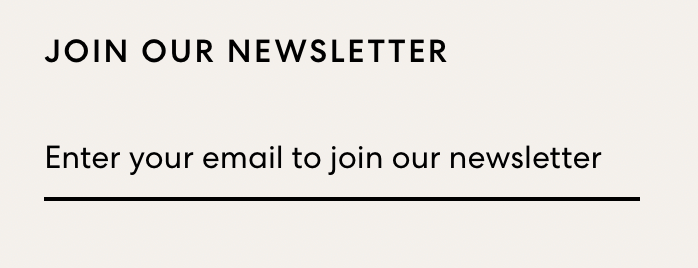
If yes, you’re not alone.
Many of the world’s largest brands don’t even capture emails, let alone use email capture copy that’s enticing and motivating for leads (in fact, the example above is from a well-known company).
But as we all know, building an email list is crucial to any business, so if you’re not doing it (or your email capture copy sucks), you’re missing out on leads that could become customers.
However, capturing emails isn’t always easy.
You may not know how to phrase the offer. You may not know which email capture mechanism is best for your brand. Hell, you may not even know what kind of offer is appropriate for your audience.
If you’re struggling to write effective email capture copy, check out some of my favorite tips below that will help you clarify your offer, engage visitors, and get more subscribers.
I broke up the tips into two categories:
The first category focuses on the basics; you want to make sure you nail these first before moving onto the second category, which is more about the fun stuff / testing ideas.
Let’s dive in, starting with The Basics!
Rule #1: Be specific with your offer
The first rule is very simple:
Tell people what they’re getting when they provide their email address.
Is it a free download? A discount code? A report? Quiz results? Directions? A free mug? Entry into a contest?
Whatever it is, make sure you clearly explain what you’re offering and what they’ll get once they join your email list.
And whatever it is, it should probably be stated in the headline – and repeated in the subheadline and CTA, as well.
Once you know what the offer is, here’s a few tips for how you can get specific with the language and persuade people to join:
✓ Get detailed
List out everything subscribers get in order of importance or persuasiveness.
For example, what’s in the free report or eBook? What kind of content do you publish through your newsletter? What do subscribers get as a member of your community?
When describing what you’re offering, use words that are specific to your product/brand.
For example, if you run a gardening newsletter, don’t say “free tips”– go with “free plant care tips” or something even more specific like “free plant care tips that are guaranteed to keep your plants alive this spring.”
This email capture copy from Marie Forleo does a great job of grabbing attention with an engaging headline and then using the subheadline to go into more detail around what the offer is and how it will benefit the subscriber.
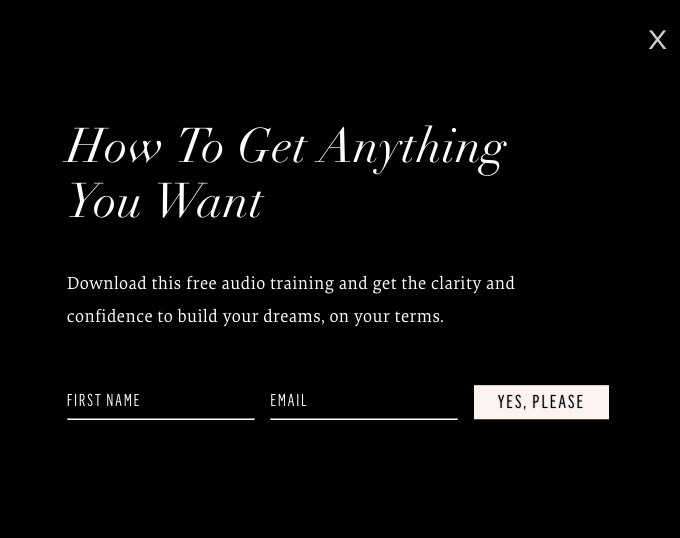
With the email capture copy above, I know:
The offer: Free audio training
How it will benefit me: It will teach me how to “get anything I want” and “how to get clarity/confidence to build my dreams, on my terms”
✓ Focus on results and outcomes
Tell people what they can achieve once they receive the offer.
What kind of benefits will they receive? What kind of results can they expect? How will their life change once they have that thing you’re offering?
For example, if you run a plant care newsletter, some of the benefits/outcomes could be things like:
- Tips for keeping your plants alive longer
- Guides on how much water each plant should get
- Learn how to select the right plants for your environment
And so on.
The example below from ThirdLove (which uses a quiz as the mechanism for capturing email addresses) uses an attention-grabbing headline that focuses on a common problem their audience has, followed by the promise of a specific outcome (“Find my perfect fit”).
They also do a great job of setting clear expectations (“Find out in 60 seconds” and “Take our Fit Finder Quiz”) so the user knows exactly what will happen next.
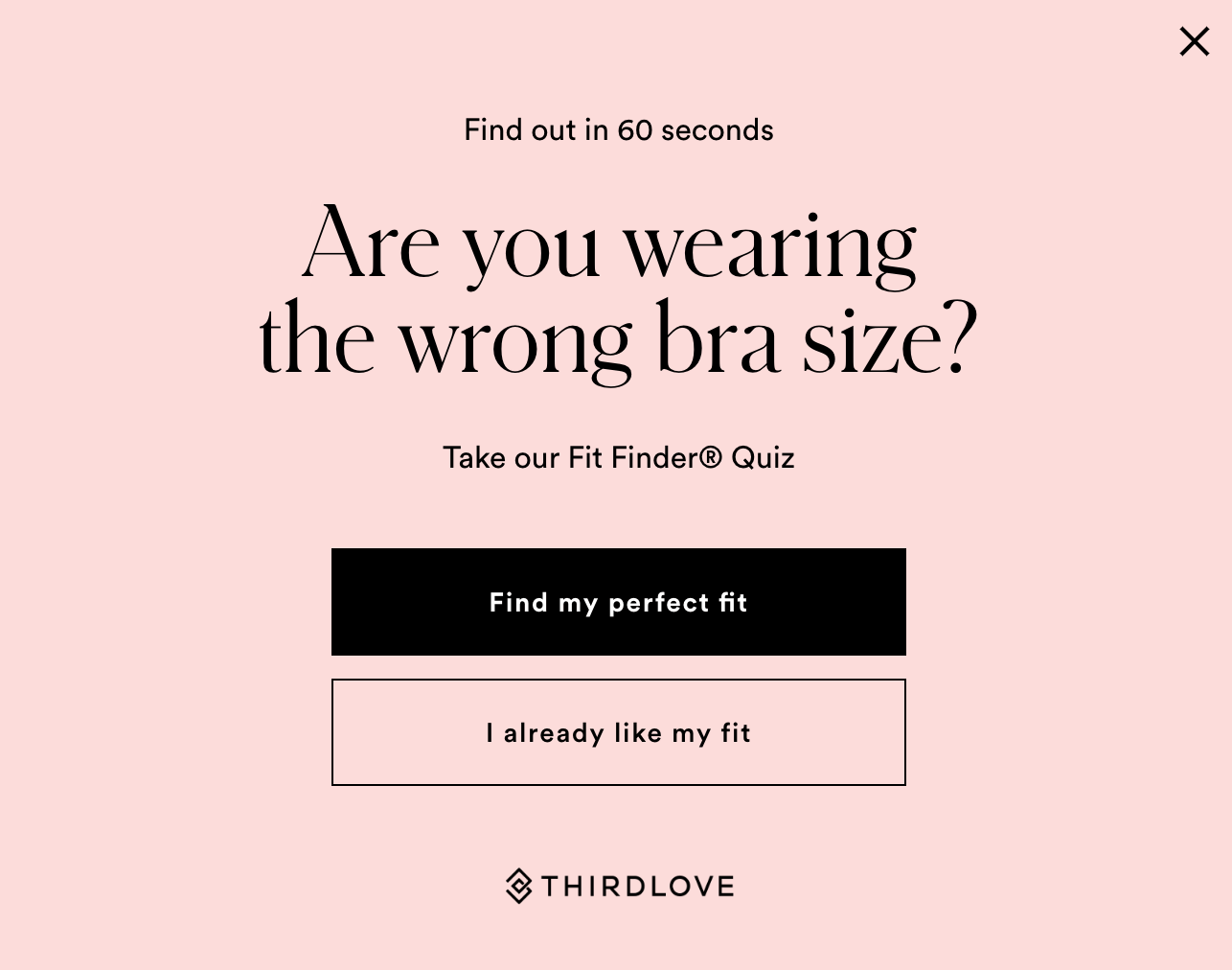
Here’s another great example of email capture copy that highlights results and outcomes – it’s from KC Baker, a women’s coach who hits on all of my tips (and more!) in one example by:
- Using an engaging headline that speaks to the desires of her target audience
- Mentions the offer in the subheadline (4-part training program)
- Lists out all the results/outcomes you can expect to achieve
- Addresses concerns around privacy/SPAM below the CTA
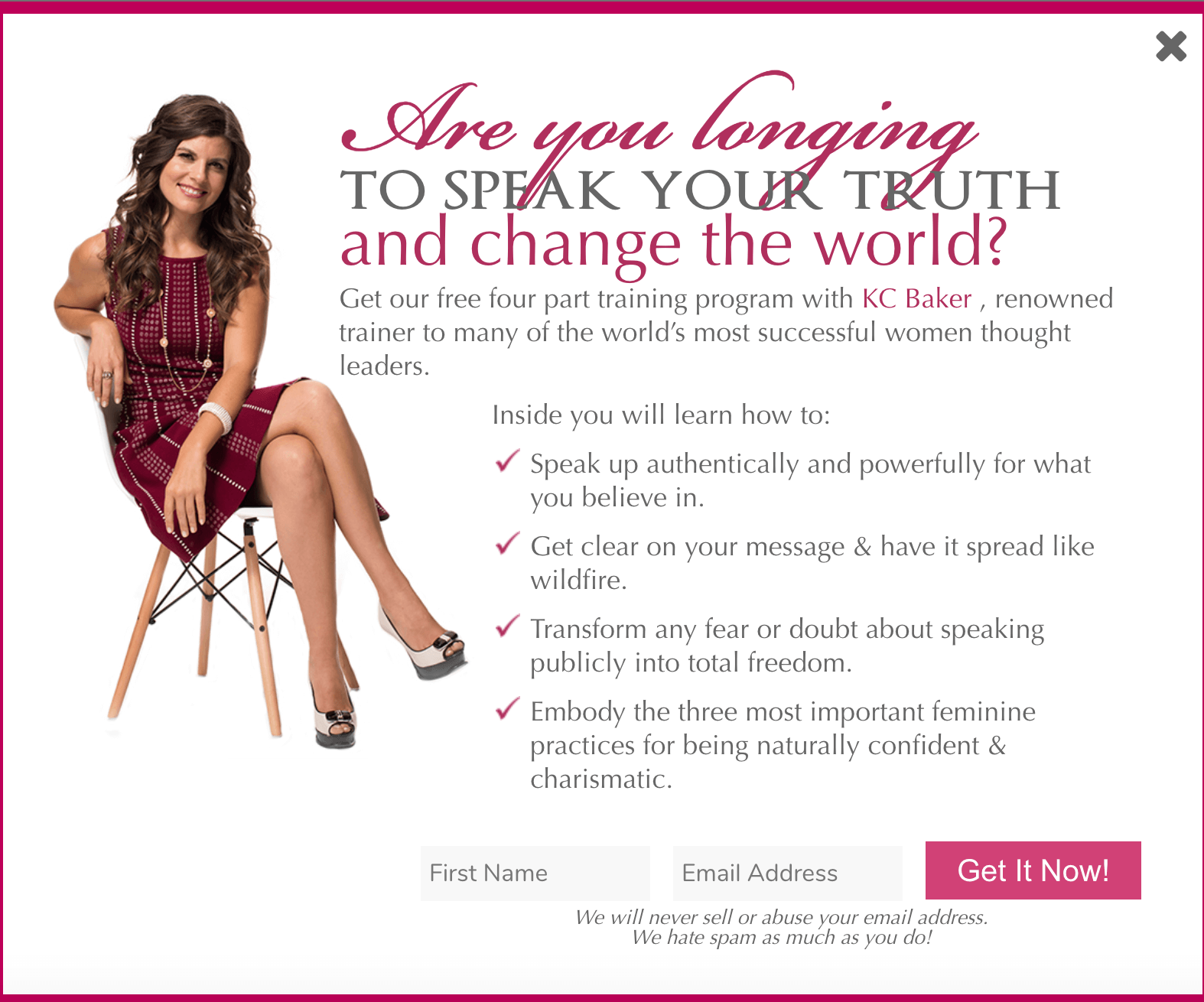
✓ Highlight value when possible
Tell people the value of what you’re giving away to make it feel irresistible.
If it’s a physical product, state the known value of it.
If it’s a digital product, state the perceived value (this can be calculated through things like time spent, hours or money saved, ease of use, convenience, by looking at how the market/your competitors’ value similar products, etc).
The email capture copy from Polywood is a great example of not only stating the offer clearly and persuasively (the chance to win a free chair), but the value ($199+), as well.
They also set expectations below the CTA by explaining how many winners will be chosen and when they’ll be selected (I would go even further and add something like “winners will be notified via email and announced on our social channels” to build trust and legitimacy).

P.S. I entered that ^ giveaway and didn’t win 💩! 😹
Rule #2: Set clear expectations as to what will happen once they subscribe
The second tip is just as simple as the first:
Tell people what will happen when they submit their email address. And perhaps just as importantly, tell them what WON’T happen once they submit.
Here are a few things to keep in mind when trying to set clear expectations in your email capture copy:
✓ Remind them of what they’re getting
If they’re receiving something, remind them of what they’re getting (i.e. a discount, lesson, eBook, etc) either in the subheadline or CTA.
For example, copywriter Anna Bradshaw does this well by stating the offer in the subheadline and again in the CTA – this kind of repetition can increase believability/trust while also reinforcing the visitors’ decision to take action.
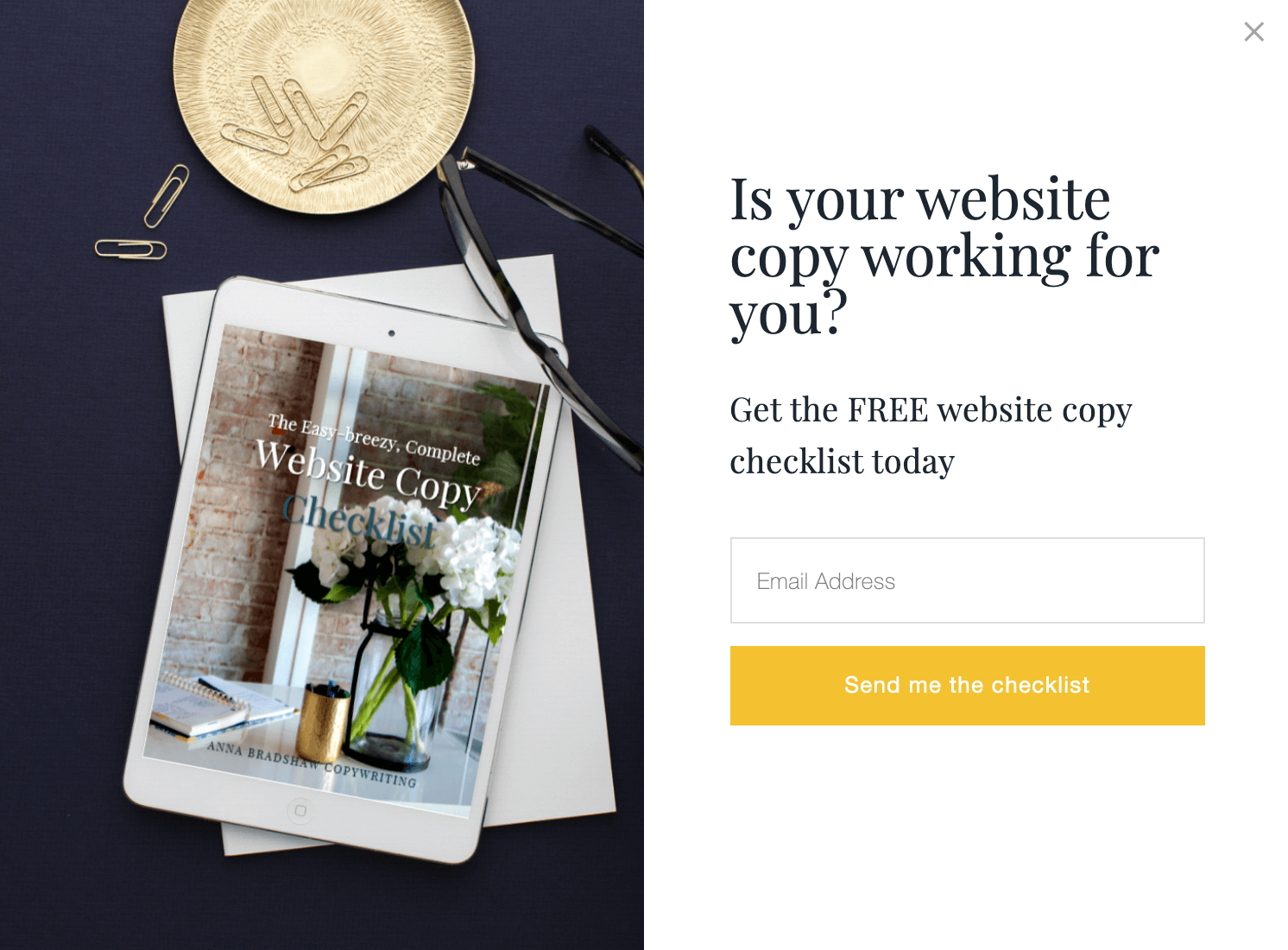
✓ Address delivery/frequency
If it’s a newsletter, tell them how often they can expect it.
If it’s a product or discount, tell them when it will arrive (i.e. instantly, within 24 hours, within a week, etc) and where they can find it (i.e. in their email, in their mailbox, etc).
If it’s a giveaway, tell them when/how the winners will be selected and notified.
If it’s an event, tell them when it is and how they can get in.
You get the idea!
While I can’t recall the source, the example below does a good job of setting expectations around delivery/frequency with the copy “You’ll receive our twice-weekly newsletter and occasional special offers and notices.”
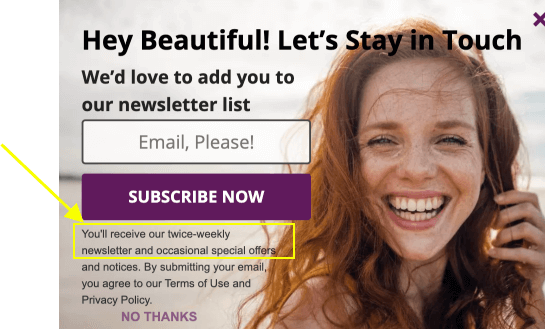
✓ Overcome potential objections
We all know the pain of receiving unwanted emails, which is why some visitors may be hesitant to give you their information.
By directly addressing potential concerns around things like SPAM, sharing of customer information, terms and conditions, etc, you’re more likely to assuage their fears and get them to take action.
While the example above from KC Baker is the best of the bunch (with the copy “We will never sell or abuse your email address. We hate spam as much as you do!”) the example below (I can’t recall the source) also does something similar, but in a more light-hearted way:
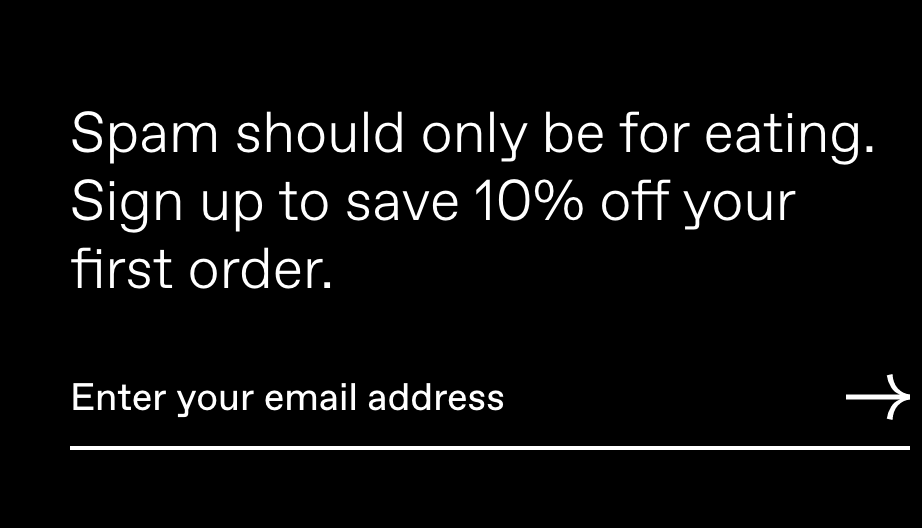
Rule #3: Make your CTA clear and persuasive
While the headline and subheadline are important, the CTA should never be ignored as it’s the last barrier between your visitor and the thing you’re offering.
For this reason, I recommend reiterating what subscribers getting in the CTA using clear and simple language, like in the example below from my friend Laura Elizabeth who runs Double Your Freelancing with her husband, Brennan Dunn.
This example also reiterates the offer in the CTA (“Get Lesson 1”) and uses design elements (like the arrow) to direct your attention to the action they’d like you to take.
It also uses trust-building elements (like their faces and the media logos) to infuse legitimacy and to help overcome any lingering objections.
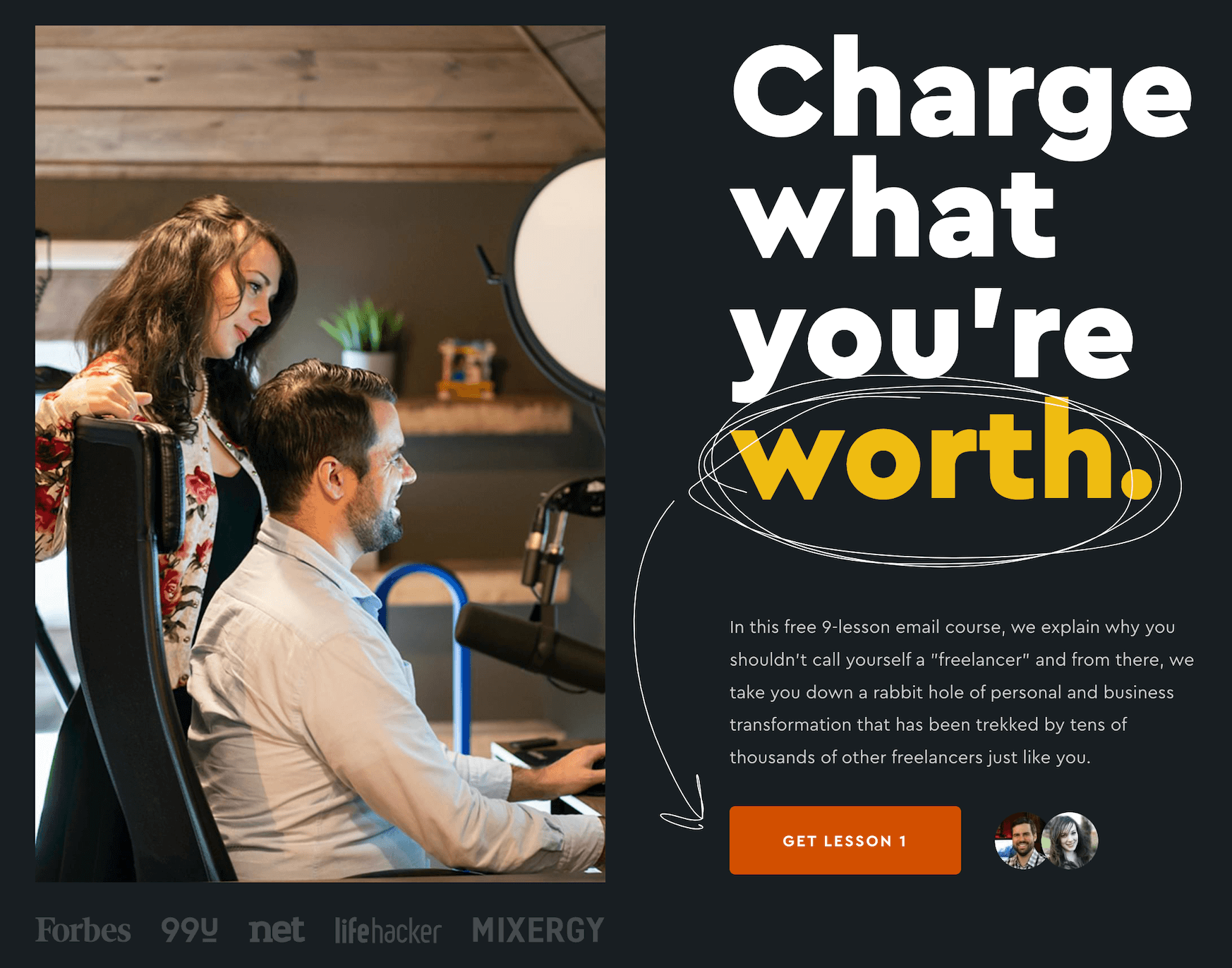
The example below from Us Weekly takes a similar approach, but they take it a step further by highlighting what visitors are missing out on by not subscribing (and as we all know, FOMO can be a highly persuasive conversion tactic):

Alright, those are the basics. Now let’s talk about the fun stuff you can mess around with and test!
Rule #4: Try collecting user information (if applicable)
If it makes sense, try an email capture mechanism that allows you to collect visitor information to help you understand who your visitors are, what they’re looking for, etc.
Having a little extra info on your visitors can help you better tailor your offer, website content, emails, and more.
For example, my former client Coterie Party asks potential subscribers to tell them more about the kind of party they’re planning and when it is to help shape the content the user receives:
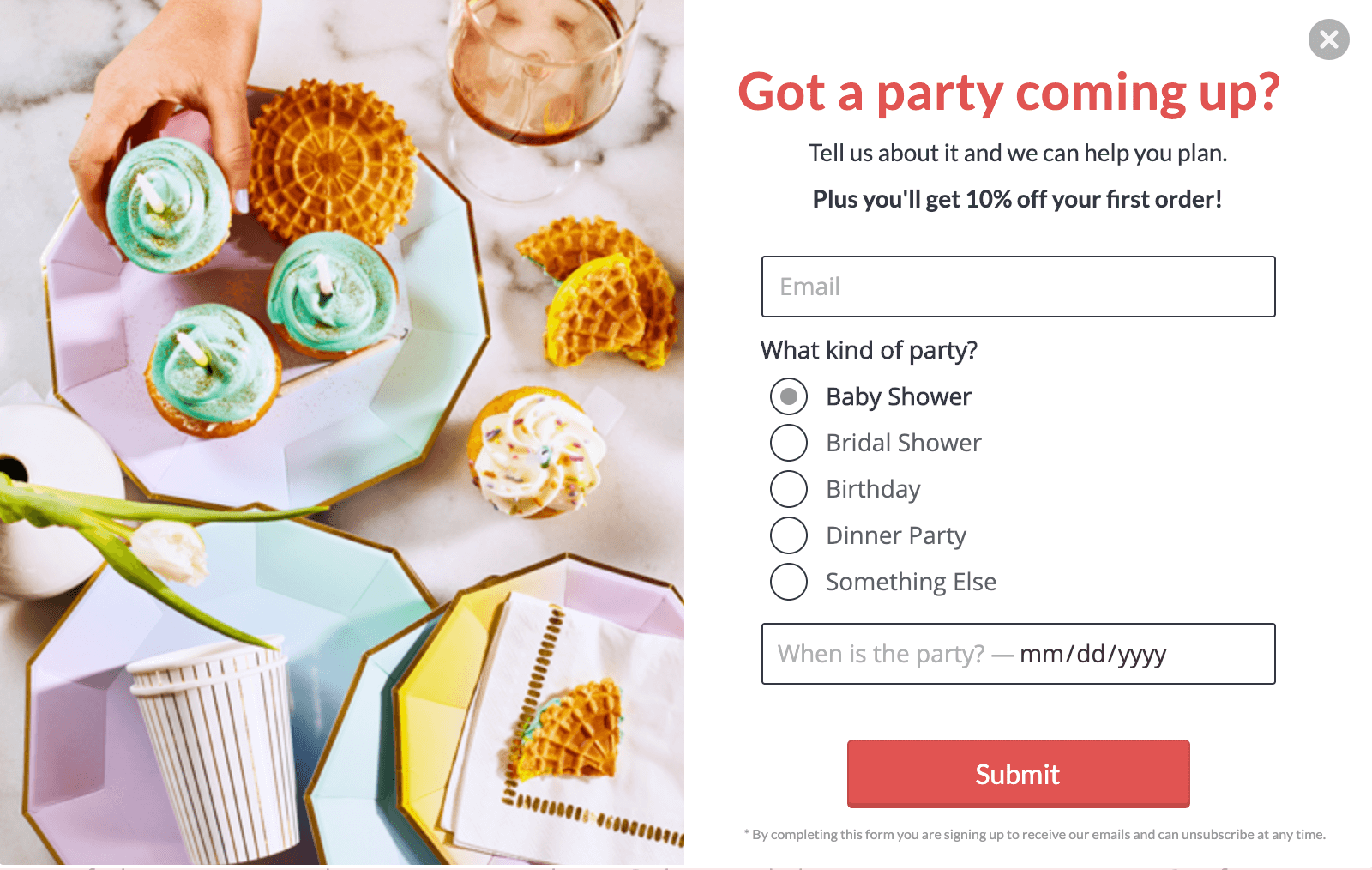
Here’s another example from Neil Patel; he uses an “SEO analysis” as the email capture mechanism to provide the user with highly personalized content.
After the analysis is complete, the user is served a screen that asks for your email with a request to book a call (not a bad way to capture email addresses and get leads on the phone!).
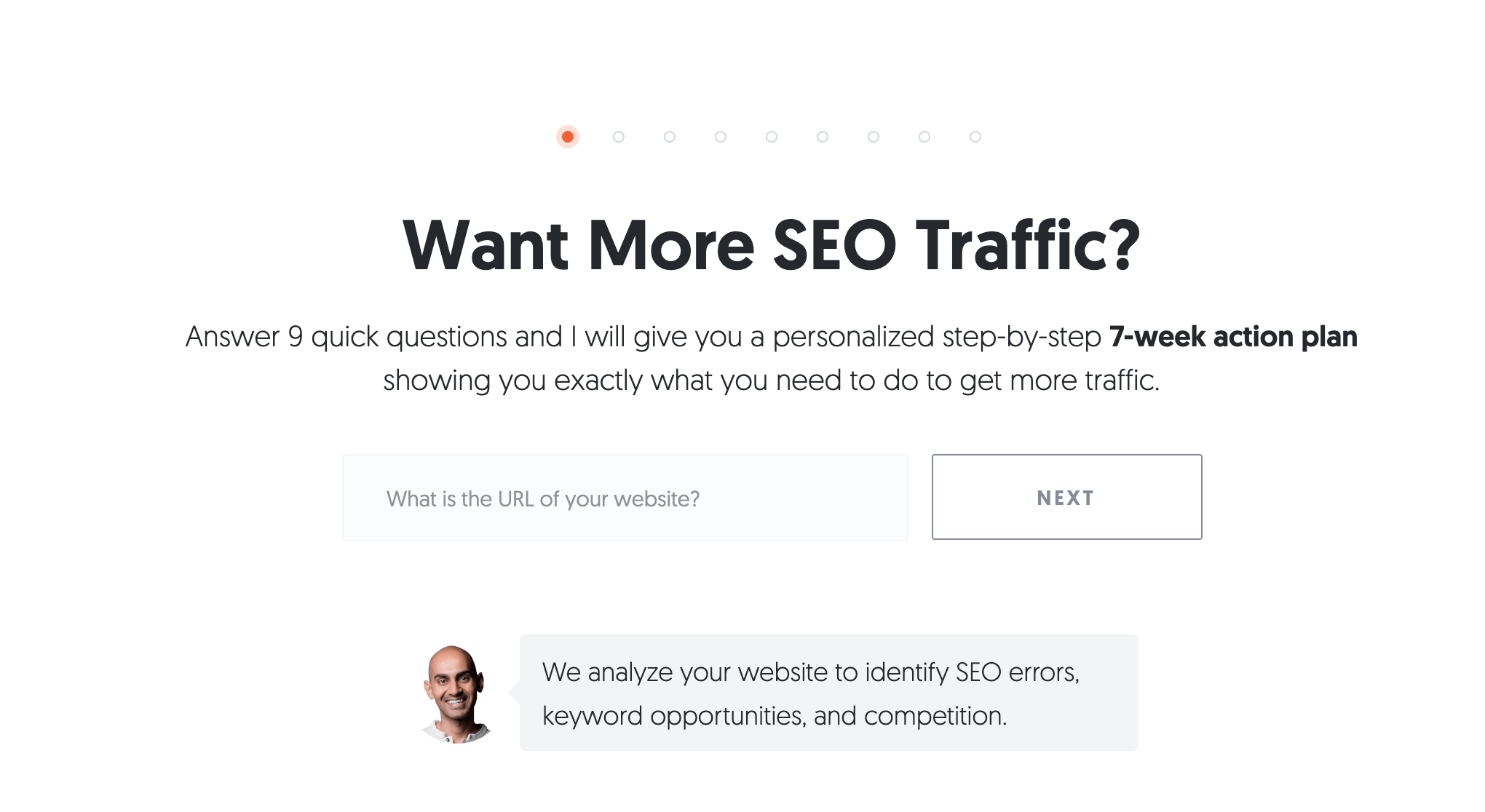
Rule #5: Try infusing your brand tone / personality
To help you stand out and connect with your audience, test email capture copy that infuses your unique brand personality and tone.
For example, the lingerie company fleur du mal does this well with the simple copy, “Take it off, baby!” to connect their brand personality (sassy, sexy, bold, etc) with their offer (15% off).

Here’s another example from the plant company, The Sill. They use the headline “Get the dirt” as a cheeky nod to their brand and to the content within their newsletter:
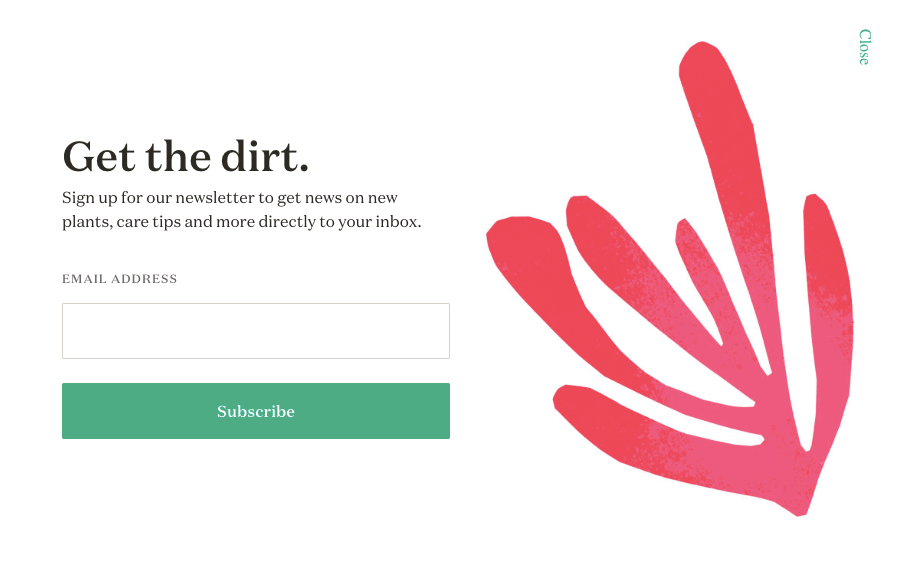
Rule #6: Try to have some fun!
While building an email list is serious, your email capture copy doesn’t have to be – and this is especially true for brands who have a more fun and playful personality.
If it makes sense for your brand, don’t be afraid to use humor, get cheeky, subvert expectations, or be relatable by acknowledging the visitors’ pain points (or thoughts) directly.
For example, the now-defunct wedding brand, Floravere, used to have this cheeky email capture copy that spoke to a common pain point / desire of their audience (wanting a wedding planner or someone totally focused on your wedding) as a way to get sign-ups.
It also asks for the subscriber’s wedding date as a way of sending more personalized content.
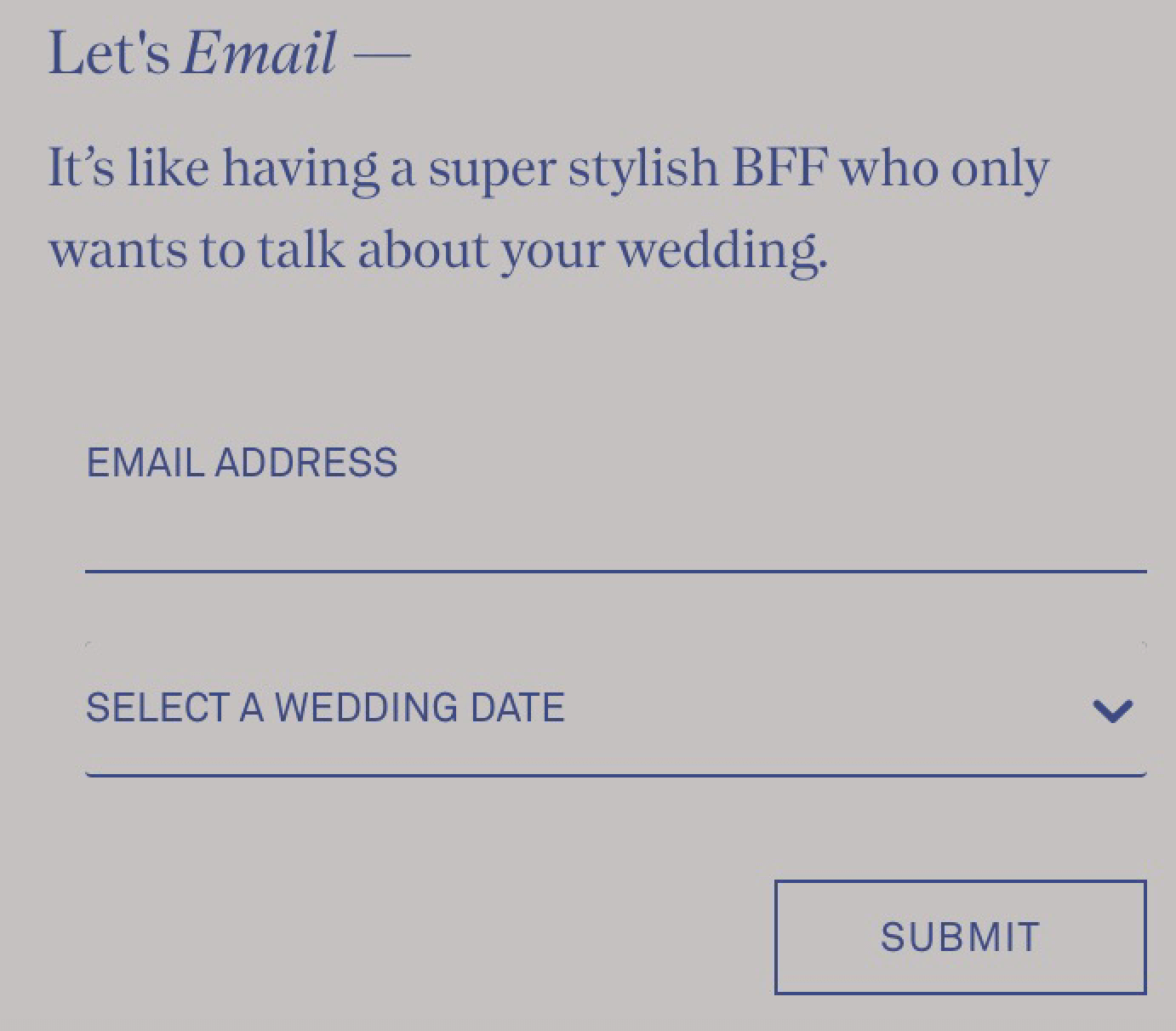
I wish I could recall the source, but this is another great example of having fun with your email capture copy, while also clearly communicating the offer (free shipping):
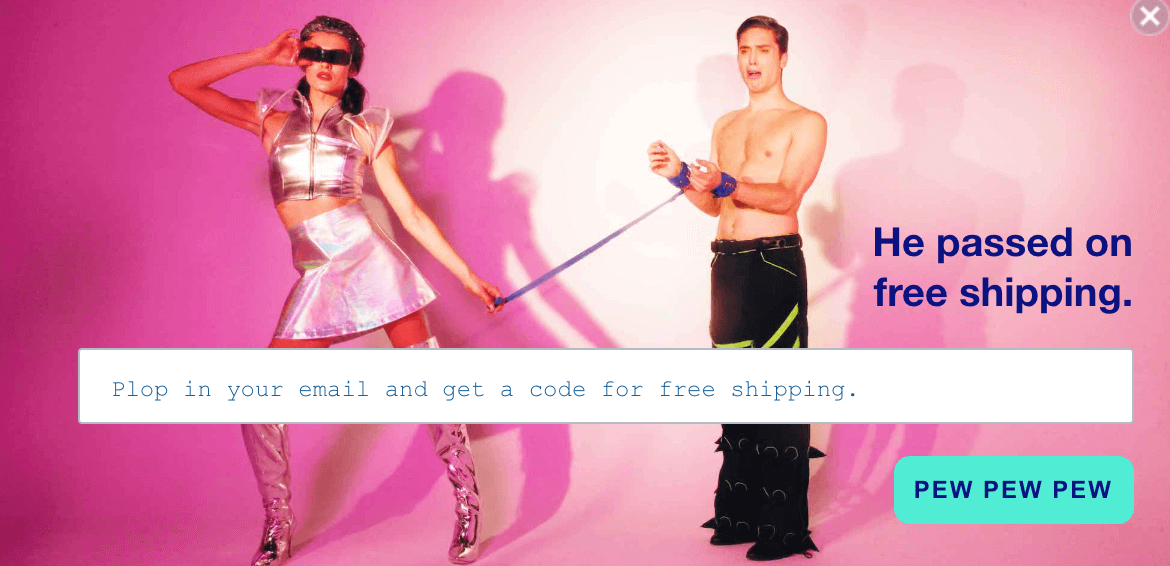
What are your tips for writing effective email capture copy?
I hope you found my tips helpful, but I’m curious: Do you have any email capture tips that have worked for your business or clients?
Share your thoughts below, and if you found this article useful, share it with a friend or colleague!
